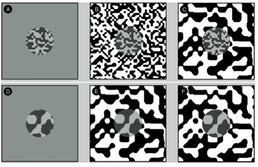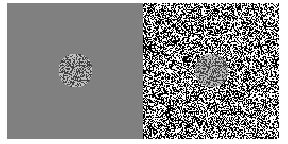The Chubb illusion is an error in visual perception in which the apparent contrast of an object varies substantially to most viewers depending on its relative contrast to the field on which it is displayed. These visual illusions are of particular interest to researchers because they may provide valuable insights in regards to the workings of human visual systems.
An object of low-contrast visual texture surrounded by a field of uniform visual texture appears to have higher contrast than when presented on a field of high-contrast texture. This illusion was observed by Charles Chubb and colleagues and published in 1989. An empirical explanation of the Chubb illusion was published by Lotto and Purves in 2001.
Imperfect transmittance[]

In 2001, Lotto and Purves demonstrated that the Chubb illusion can be explained "by the degree to which imperfect transmittance is likely to have affected the light that reaches the eye." These observations suggest a wholly empirical explanation of the Chubb illusion.
They doubted that illusory perceptions of brightness were explained as consequences of lateral inhibition. If that were the case, the perceived differece in brightness of target elements, illustrated in Figure 3 (A), would be largely unaffected by the surrounding field in Figure 3 (C), which exhibits lower spatial contrast than the target, which matches the observations.
Despite this, they asserted, "this reasoning is undermined by the fact that the apparent contrast by the target pattern in Figure 3 (D) is mostly unaffected by the surround of Figure 3 (F)." Therefore, they chose to examine the Chubb illusion in 'wholly empirical' terms, as mainly a consequence of past experience, or in this case, the influence of transmittance on ambiguous stimuli.
The common denominator of the Lotto and Purves observations is the explanatory power of imperfect transmittance. Imperfect transmittance causes observers to experience a reduced difference in spectral contrast or luminance from object surfaces. This is because imperfections in the transmission medium produce, such as atmospheric effects distort transmittance.
For instance, transmittance varies when viewing objects from a distance, in smog or fog, or through fabric, glass or water. These conditions greatly effect the amount of light that reaches the eye. In some cases, the relative luminance of two target surfaces can be reduced, as Lotto and Purves demonstrate, from a ratio of 8:3 to approximately 7:5. If perception is generated empirically, then "the extent that a stimulus is consistent with imperfect transmittance...will be incorporated into the perception of the target."
The Chubb stimulus illustrated in Figure 1 (B) is consistent with transmittance distortions for two reasons: the patterned elements of the background are continuous with the patterned elements of the target and the luminances of the target elements accord with the values that would arise if the background pattern were viewed through an imperfectly transmitting medium.
The transmittance explanation of the Chubb illusion asserts that changing the stimulus in Figure 1 (B) in a way that makes it less consistent with viewing through an imperfect medium should decrease, or reverse, the illusion. Trials confirm this hypothesis. This explanation throws into doubt the hypothesis that implies that altering luminance, motion, or spectral distribution of the field surrounding the target would not alter perception.
The empirical findings also contradict the hypothesis that 'illusions of brightness' caused by contour junctions in the stimulus explain the Chubb illusion, as proposed by Anderson, as in in 1997.
Contrast illusion[]
The Chubb illusion is similar to another visual illusion, the contrast effect. The contrast effect is an illusion in which the perceived brightness or luminance of an identical central visual target form on a larger uniform background varies to the test subject depending on the ratio of the central form's luminance to that of its background.
This illusion, simultaneous contrast, is illustrated in Figure 2. In it, the central target is brighter. I.e., the ratio of the top central rectangle’s luminance (A) to its background field's luminance is greater than one. In the bottom rectangle (B), the background field is brighter. That is, the ratio is less than one.Although the two central target patches are equally bright (identical in luminance) the one on a dark background appears lighter and the one on a lighter background appears darker.
Lateral inhibition is one proposal to explain the contrast illusion. Its advocates theorize that neurons strongly stimulated by the background of B suppress the less strongly stimulated neurons of the interior rectangle.
In A, they theorize, there is no such inhibition. However, the fact that both A and B appear of "uniform lightness across their expanse" suggests that the process of lateral inhibition is more complex. Chubb et al. assert that the principle of lateral inhibition rests on the assumption that the determining factor of perceived lightness is the ratio, at the rectangle edge, of rectangle luminance to background luminance.
External Links[]
- An Empirical Explanation: Chubb Illusion, from Dale Purves Lab.


